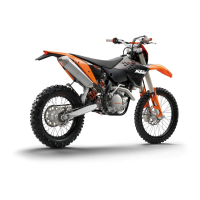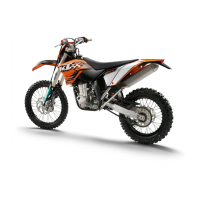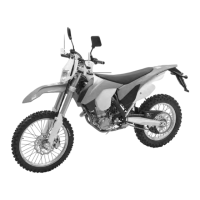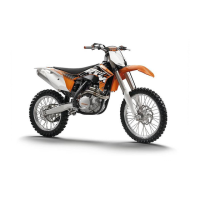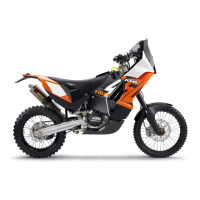
 Loading...
Loading...
Do you have a question about the KTM 450 Rally Replica and is the answer not in the manual?
| Engine Type | Single-cylinder, 4-stroke |
|---|---|
| Displacement | 449.3 cc |
| Cooling | Liquid cooled |
| Fuel System | Keihin EFI, throttle body 44 mm |
| Transmission | 6-speed |
| Starter | Electric starter |
| Bore x Stroke | 95 mm x 63.4 mm |
| Compression Ratio | 12.75:1 |
| ABS | No |
| Seat Height | 960 mm |
| Dry Weight | 139 kg |
| Frame | Chromoly steel central-tube frame |
| Front Suspension | WP XACT PRO 48 mm, closed cartridge |
| Rear Suspension | WP XACT PRO with Trax technology |
| Front Brake | 300 mm |
| Rear Brake | Single disc, 240 mm |
Defines KTM sport motorcycles' design for competitive use and adherence to regulations.
Prerequisite for operation and prevention of wear through proper service and tuning.
Details warranty conditions and voiding for work not done by authorized KTM workshops.
Outlines special tools, non-reusable parts replacement, and thread locker usage.
Provides notes on safe transport, danger of damage, and fire hazard precautions.
Emphasizes responsible motorcycling for environmental consciousness and respect for others.
Instructs to pay close attention to information and warning labels affixed to the vehicle.
Defines risk levels: Danger, Warning, Caution, and Note with corresponding injury potentials.
Highlights the importance of reading the manual for operation, handling, and servicing information.
Provides step-by-step instructions on how to lock the motorcycle's steering.
Details the procedure for unlocking the motorcycle's steering mechanism.
Offers safety advice, pre-ride checks, and handling tips for new riders.
Guides on engine break-in procedures, specifying speed and performance limits.
Lists essential pre-trip checks for safe vehicle operation, including fluids and tires.
Provides safety warnings for starting the engine and advice on cold engine starting.
Details the procedure for starting off, including clutch and throttle control.
Explains gear shifting, safe riding practices, and clutch usage.
Offers advice on effective braking, adapting to conditions and avoiding wheel lock-up.
Provides instructions on stopping, parking safely, and securing the vehicle.
Details safety precautions for refueling, including fire and poisoning hazards.
Presents a table of regular checks and maintenance tasks based on operating hours.
Lists service tasks recommended as additional orders based on operating hours or time.
Explains how to adjust suspension components to match the rider's weight.
Describes high-speed and low-speed compression damping ranges for the shock absorber.
Details the procedure for adjusting shock absorber high-speed compression damping.
Provides steps for adjusting shock absorber low-speed compression damping.
Explains how to adjust the rebound damping on the shock absorber.
Guides on measuring rear wheel sag with the motorcycle on a lift stand.
Describes how to check the static sag of the shock absorber.
Details how to check the riding sag of the shock absorber with rider weight.
Provides instructions for adjusting the shock absorber's spring preload.
Explains how to adjust the riding sag by changing the spring.
Discusses fork settings, spring preload, and heavier springs for overloaded forks.
Details how to adjust the compression damping on the fork legs.
Explains how to adjust the rebound damping on the fork legs.
Describes how to check for play in the steering head bearing.
Provides steps for adjusting the steering head bearing play.
Guides on checking chain tension and its importance for drivetrain components.
Provides steps for adjusting chain tension using adjusters and nuts.
Explains how to check wear on the chain, sprockets, and chain guide.
Instructs on checking the frame for cracks or deformation due to mechanical impact.
Details how to check the swingarm for damage, cracking, or deformation.
Details how to check the hydraulic clutch fluid level.
Provides instructions for changing the hydraulic clutch fluid.
Explains how to check free travel on the hand brake lever to prevent system failure.
Details how to adjust hand brake lever free travel using an adjusting screw.
Guides on checking brake disc thickness and for damage, cracks, or deformation.
Instructs how to check the front brake fluid level and identify leaks.
Provides steps for adding front brake fluid, emphasizing correct type and safety.
Explains how to check front brake lining minimum thickness and for damage.
Details the procedure for changing the front brake linings.
Guides on checking free travel of the foot brake lever to prevent overheating.
Provides steps for adjusting foot brake lever free travel using a screw.
Instructs how to check the rear brake fluid level and identify leaks.
Provides steps for adding rear brake fluid, emphasizing correct type and safety.
Explains how to check rear brake lining minimum thickness and for damage.
Details the procedure for changing the rear brake linings.
Explains how to check the engine oil level when the engine is cold or warm.
Details the procedure for changing engine oil, oil filter, and cleaning the oil screen.
Provides instructions for adding engine oil, emphasizing correct type and level.





